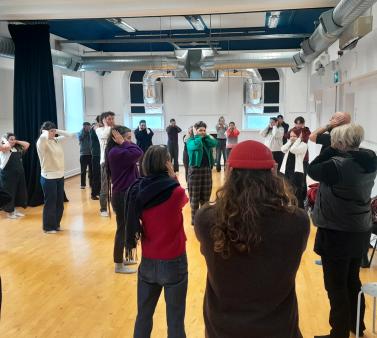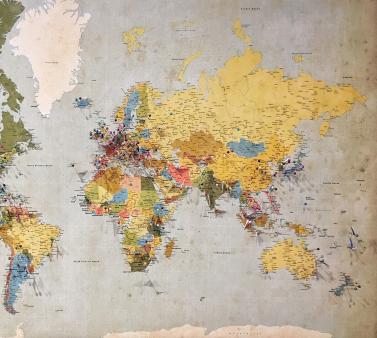In 1999, she wrote, directed, produced, and photographed her first film, Death: A Love Story. It was nominated for the Grand Jury Prize at the Sundance Film Festival and aired on national public television (PBS) in the US and CBC Canada. Today, Death: A Love Story is currently used in classrooms in over 500 universities and colleges in the US and Canada. In 2002, Ms. Le Brun founded HARKEN! Youth Media, providing Participatory Video based filmmaking opportunities to youth. In addition to teaching in the Film Media and Communications departments of the University of Rhode Island (URI), Michelle taught in the Integrated Arts and Learning Graduate Masters Degree Program at Lesley University for 23 years, delivering seminars nationwide in Drama and Critical Literacy.
On what brought her to Rennes 2 University:
At URI, I teach in both the Communications and Film Media departments, teaching documentary production, media literacy, and a variety of film studies courses. The new course, which I’m now adapting here, is called Cultural Identity and Media. When I do it in the US, my students actually make their own short videos. Here, I’m doing all the other components of the course except for the video-making piece, which hopefully, should I come back, is something I could integrate into the course in the future. We look at Autoethnography, Media Literacy and Participatory Video. I teach students critical ways to look at texts using media literacy techniques, be it written texts, commercials, documentaries or whatever we see and hear as messages these days. The goal is to also teach them to analyze their own values and media-making practices, which is something that is really important in today’s participatory society. I feel this kind of course is incredibly timely and relevant, and students who take it tend to love it.
On her film Death: A Love Story and its critical success:
I made the film in 1999, and it’s been amazing to see all of the various lives it has had in distribution over the years. My late husband was a film producer and after hearing about my experience sitting with my husband as he died, his friends all suggested I make a film. The experience provoked a profound spiritual opening for me. So, I made the film about this very personal experience and it was really surprising to see how well-received it was. People were and still are hungry for alternative views about how to be with our loved ones as they pass.
It premiered at the Sundance film festival and ended up being in competition. When that happens you get a tremendous amount of attention. Suddenly, HBO and other networks were calling me for potential distribution. The film has had 5 different distribution outlets and is now available in the educational market and streaming. An analysis of the film was featured in Sundancing (2000), by John Anderson, History in Documentaries (2005), by Alan Rosenthal (China edition), and Documentary Media (2018), by Broderick Fox. Overall, it has been subject to a variety of distribution agreements over the years. Suffice to say, I am very grateful.
In the educational market, it’s available in over 500 universities in the US and Canada. It's used in everything from palliative care to nursing, sociology, and psychology. I also co-facilitate a workshop in medical schools around the country with Dr. Mitchell Levy, Professor at Brown’s Medical School, around contemplative approaches to end-of-life care. And it’s been incredibly moving over the years to get emails from people who basically say that the film has made a profound difference in their lives. It’s such an honor; it’s beyond filmmaking.
The goal is to teach the youth to master their environment by learning storytelling, technical skills associated with camera work, interviewing, and editing as well as civic engagement to be able to tell compelling stories about pressing issues in their communities.
On starting HARKEN! Youth Media:
After my husband died I needed to find work. I found job working with incarcerated youth at Soledad Enrichment Action. At the time, many kids of color were being looked at as “Superpredators”. I wanted to help give these kids a voice and teach them to use the technology and media literacy to get their stories and experiences of racism and violence out using their own words. So I pitched the idea of working on a youth media program to someone I was in contact with. They decided it was a good idea and funded it for a year.
I started with a budget of 30,000 USD, and I went out and bought a bunch of cameras and started teaching the youth how to shoot, take sound, interview and edit. That’s really when I first started doing the media literacy work as well. In addition to introducing students to a variety technical and creative skills in video production, I took a "social justice/social science" approach throughout the entire process of the training and production. The essential question I asked them was, what do you see out in the world? Needless to say, the themes that kept coming back throughout these discussions were institutional racism and violence.
On being part of the World Festival of Sacred Music:
The project came about through a friend who lives in Los Angeles. Judy Mitoma, who was the head of a World Arts & Cultures/Dance department at the University of Southern California, L.A., was asked by His Holiness the Dalai Lama for help in ushering in the new millennium in the spirit of world peace and reconciliation. He was really the vision behind the project - the vision being that the one thing that can unify people across language and cultural barriers is music. As a result, she initiated the World Festival of Sacred Music in 1999, which she produced again in 2002 and 2005. Many filmmakers from all over the world were hired to go and cover the Festival. Each musical company had a filmmaker assigned to it. I had just gotten back from Bali and so I was asked to cover the Balinese group, Gamelan Sekar Jaya, who participated. I got to meet the Dalai Lama and many inspiring people. It was an honor to be invited to be one of the filmmakers for this festival.
In 2005, I brought the HARKEN! Youth Media program to Providence, Rhode Island and continued it with a similar population of youth-at-risk. The goal is to teach the youth to master their environment by learning storytelling, technical skills associated with camera work, interviewing, and editing as well as civic engagement to be able to tell compelling stories about pressing issues in their communities.
On any future projects with Rennes 2:
In terms of collaborations, there is nothing concrete yet, but I’m definitely hoping that we will be able to continue working together. I was talking with a few people from the International Relations Office and the Communications Department and we discussed the notion of possibly co-teaching online together in a structure that would have both American and French students making films and giving feedback on each other’s projects as well. Whatever the theme of the course is, production could be involved, and students would ideally be able to show each other their productions at various stages with a live debate about it in real-time. We are also talking about ways to bring some of the faculty from Rennes 2 to the University of Rhode Island.
So, hopefully that will come to fruition. In any case, I’ve really enjoyed my time in Rennes. I’ve been to France several times before, and even lived in Paris in the 1980s, but there are several things that I enjoyed about Rennes. Florian Hemont, Marcela Petrascu, Gudrun Ledegen, and all the faculty in the Communications Department really treated me well and we had very meaningful exchanges about the role of communications in the world today, particularly during this difficult time of “les greves”. I would love to have some sort of ongoing relationship with Rennes 2 University in the future.




